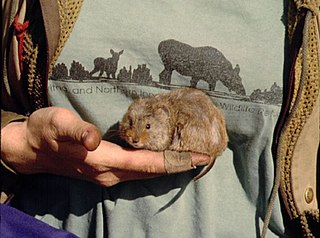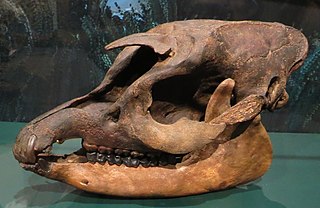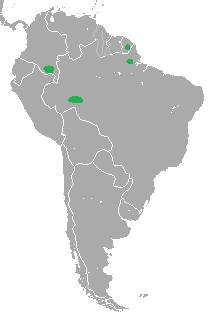
Odd-toed ungulates, mammals which constitute the taxonomic order Perissodactyla, are animals—ungulates—who have reduced the weight-bearing toes to three or even one of the five original toes. The non-weight-bearing toes are either present, absent, vestigial, or positioned posteriorly. By contrast, the even-toed ungulates bear most of their weight equally on two of the five toes: their third and fourth toes. Another difference between the two is that odd-toed ungulates digest plant cellulose in their intestines rather than in one or more stomach chambers as the even-toed ungulates do.

A tapir is a large, herbivorous mammal, similar in shape to a pig, with a short, prehensile nose trunk. Tapirs inhabit jungle and forest regions of South and Central America, with one species inhabiting Southeast Asia.

The South American tapir, also commonly called the Brazilian tapir, the Amazonian tapir, the maned tapir, the lowland tapir, in Portuguese anta, and in mixed Quechua and Spanish sachavaca, is one of the four widely recognized species in the tapir family, along with the mountain tapir, the Malayan tapir, and Baird's tapir. It is the largest surviving native terrestrial mammal in the Amazon.

Tapirus is a genus which contains the three living American tapir species. The Malayan tapir is usually included in Tapirus as well, although some authorities have moved it into its own genus, Acrocodia.

The mountain tapir, also known as the Andean tapir or woolly tapir is the smallest of the four widely recognized species of tapir. It is the only one to live outside of tropical rainforests in the wild. It is most easily distinguished from other tapirs by its thick woolly coat and white lips.

The taiga vole is a large vole found in northwestern North America, including Alaska and northwestern Canada. The name "taiga vole" comes from its living in the boreal taiga zone. It is also sometimes called the yellow-cheeked vole or chestnut-cheeked vole because of the rusty-yellow color on its face around its vibrisae (whiskers); The taiga voles derive their name from these features: "xantho" is Greek for yellow and "gnathus" is Greek for jaw. It is typically much larger than most other North American voles, especially those from the genus Microtus.

Xenorhinotherium is an extinct genus of macraucheniids, closely related to Macrauchenia of Patagonia. The type species is X. bahiense.

Sacisaurus is a silesaurid dinosauriform from the Late Triassic (Norian) Caturrita Formation of southern Brazil. The scientific name, Sacisaurus agudoensis, refers to the city where the species was found, Agudo in the Rio Grande do Sul state, whereas Sacisaurus refers to Saci, a famous one-legged creature from Brazilian mythology, because among the dozens of fossil material unearthed, 35 right femora were collected whereas only 1 left femur was found.

The giant tapir is an extinct species of tapir that lived in southern China, with reports suggesting it also lived in Taiwan, Java, Vietnam, and potentially on Borneo. Evidence suggests that the species first appeared in the Early Pleistocene and possibly survived until the early Holocene. It was larger on average than modern tapirs, estimations range from 2.1 metres (6.9 ft) long and 0.9 metres (3.0 ft) tall at the shoulders to 3.5 metres (11 ft) long, and 1.5 metres (4.9 ft) metres tall at the shoulders. It may have weighed up to 500 kilograms (1,100 lb). The species was also placed in its own genus of Megatapirus, however, it is now conventionally placed within Tapirus.
Tapirus californicus, the California tapir, is an extinct species of tapir that inhabited North America during the Pleistocene. It became extinct about 13,000 years ago.
Tapirus merriami, commonly called Merriam's tapir, is an extinct species of tapir which inhabited North America during the Pleistocene.

Tapirus copei, or Cope's tapir, is an extinct species of tapir that inhabited North America during the early to middle Pleistocene Epoch (~2.5–1 Ma). The fossil remains of two juvenile Tapirus copei were collected in Hillsborough County, Florida on August 31, 1963. It was the second largest North American tapir; the first being Tapirus merriami.

Tapirus kabomani is a partially-recognized species of tapir, large browsing mammals similar in shape to a pig. It is the smallest tapir species, even smaller than the mountain tapir, which had been considered the smallest. T. kabomani is found in the Amazon rainforest, where it appears to be sympatric with the South American tapir. When it was announced in December 2013, T. kabomani was the first odd-toed ungulate discovered in over 100 years. T. kabomani has not been recognized by the Tapir Specialist Group as a distinct species and recent genetic evidence further suggests it is actually nested within T. terrestris.
This article records new taxa of fossil mammals of every kind that have been described during the year 2011, as well as other significant discoveries and events related to paleontology of mammals that occurred in the year 2011.

Tapirus veroensis, commonly called the vero tapir, is an extinct tapir species that lived in the areas of modern-day Florida, Georgia, Kansas, Missouri, and Tennessee. Tapirus veronensis is thought to have gone extinct around 11,000 years ago.
Tapirus cristatellus is an extinct species of tapir from the Pleistocene of South America. Remains are known from Brazil, specifically the states of Minas Gerais and Bahia.
Tapirus greslebini is an extinct species of tapir that lived in South America during the Pleistocene.
Tapirus mesopotamicus is an extinct species of tapir that lived in South America during the Pleistocene. It is considered a possible ancestor of all extant South American tapirs.
Tapirus oliverasi is a likely invalid extinct species of tapir from South America.

Trichechus hesperamazonicus, the western Amazonian manatee, is an extinct species of manatee that lived about 40 thousand years ago in the Madeira River, in the Brazilian state of Rondonia. It is known from this single locality, with possible occurrences in the Brazilian state of Acre.










